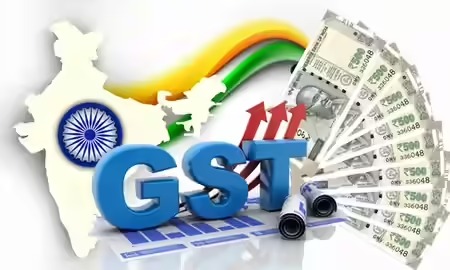 Image Source : ET CFO
Image Source : ET CFO
India’s Goods and Services Tax (GST) collection for July 2025 surged to ₹1,95,735 crore, marking a 7.5 percent year-on-year increase and reflecting sustained economic momentum and improved compliance across sectors. The latest figures, released by the Ministry of Finance, underscore the robustness of domestic consumption and import activity, even amid global trade uncertainties.
This newsletter breaks down the key components of the July GST performance, regional trends, and what the numbers mean for fiscal policy and economic planning.
Key Highlights from July 2025
- Gross GST collection: ₹1,95,735 crore, up from ₹1,82,075 crore in July 2024
- Domestic GST revenue: ₹1,43,023 crore, a 6.7 percent increase year-on-year
- GST from imports: ₹52,712 crore, up 9.7 percent compared to July last year
- Refunds processed: ₹27,147 crore, a 66.8 percent jump from ₹16,275 crore in July 2024
- Net GST revenue after refunds: ₹1,68,588 crore, a modest 1.7 percent increase year-on-year
Breakdown of July Collections
- Integrated GST (IGST): ₹1,03,536 crore
- Central GST (CGST): ₹35,470 crore
- State GST (SGST): ₹44,059 crore
- GST Cess: ₹12,670 crore
The IGST component was nearly evenly split between domestic transactions and imports, indicating balanced growth across consumption and trade.
Refund Surge and Net Revenue Trends
Refunds saw a dramatic rise, particularly in domestic claims, which grew by 117.6 percent year-on-year. Export-related refunds processed through ICEGATE rose by 20 percent. While this reflects improved efficiency in refund processing and higher export activity, it also calls for vigilant monitoring to prevent revenue leakages.
After adjusting for refunds, net domestic GST revenue remained largely stable at ₹1,26,040 crore, while net GST from imports rose 7.5 percent to ₹42,548 crore.
April–July 2025 Performance
Cumulatively, India’s gross GST collection for the April–July period reached ₹8,18,099 crore, a 10.7 percent increase over the same period last year. Net GST revenue for the same period rose 8.4 percent to ₹7,11,128 crore, up from ₹6,55,974 crore in April–July 2024.
This consistent growth trajectory reinforces the government’s fiscal stability and provides a strong foundation for future rate rationalization discussions within the GST Council.
State-Wise Trends
Several states recorded double-digit growth in GST collections, signaling healthy regional economic activity:
- Tripura: 41 percent
- Meghalaya: 26 percent
- Sikkim: 23 percent
- Nagaland: 22 percent
- Madhya Pradesh: 18 percent
- Bihar: 16 percent
Conversely, some states experienced declines:
- Manipur: -36 percent
- Mizoram: -21 percent
- Jammu and Kashmir: -5 percent
- Chandigarh: -5 percent
Post-IGST settlement data also showed growth in key states:
- Maharashtra: ₹62,832 crore (up 12 percent)
- Punjab: ₹8,697 crore (up 15 percent)
- Delhi: ₹13,168 crore (up 9 percent)
- Tamil Nadu: ₹25,034 crore (up 1 percent)
Implications for Policy and Planning
The July GST figures offer several insights for policymakers:
- Strong import and domestic revenue growth suggest resilient consumption and trade
- High refund volumes may prompt reviews of refund mechanisms and fraud safeguards
- Stable net revenue supports fiscal planning and potential tax rate adjustments
- Regional disparities highlight the need for targeted economic support in lagging states
Conclusion: A Steady Climb Amid Global Uncertainty
India’s 7.5 percent rise in GST collections for July 2025 reflects a steady economic recovery and improved tax compliance. With cumulative collections for the fiscal year showing double-digit growth, the government is well-positioned to maintain fiscal discipline while exploring structural reforms. As the GST Council prepares for its next meeting, these numbers will serve as a critical benchmark for future policy decisions.
Sources: Businessworld, JurisHour, Economic Times
Advertisement
Advertisement





